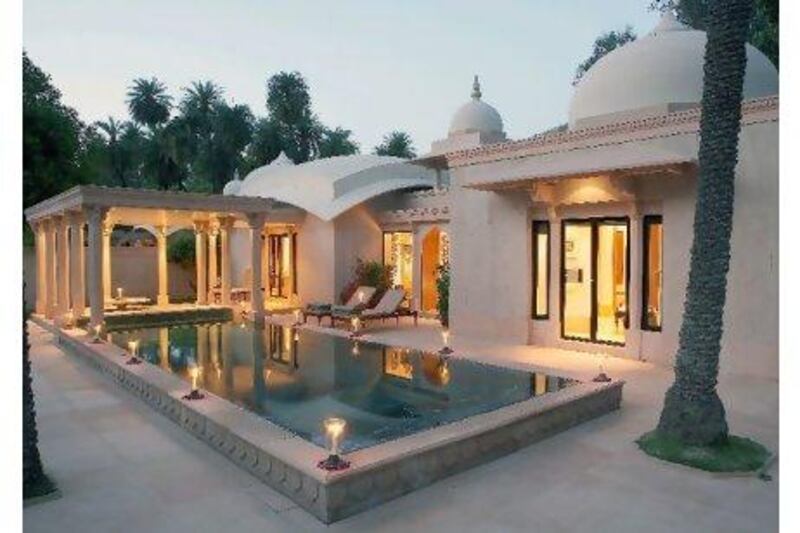The welcome
As we enter the marble and sandstone palace, three girls dressed in bright orange saris perform a welcome ceremony. One sings a Sankrit song of welcome, another ties coloured string around my left wrist and the third holds a tray of marigolds. On either side of us is a marble waterfall full of crimson rose petals. Ahead, the courtyard opens up on to the beautifully proportioned modern-day palace designed by Ed Tuttle, an American architect based in Paris. The general manager, Tim Weiland, introduces himself and we are given fresh pomegranate juice before being escorted to our haveli (villa).
The neighbourhood
Amanbagh is in the middle of India's "Golden Triangle", around a 90-minute drive from Jaipur, five hours from Delhi and about three and a half hours to the Taj Mahal. The latter can be arranged by the hotel as a day trip with stopovers for $350 (Dh1,285). The hotel site was used in the 19th century by Maharaja Jai Singh of Alwar as a base for hunting in the jungles of Sariska. The local village is Ajabgarh, and there are daily early morning walks that take you to other villages.
The hotel has only 39 rooms but took 10 years to build because of the adherence to traditional methods. It is set in a lush valley with the Aravalli hills neatly symmetrical on either side. Mature eucalyptus and palm trees were retained and in some instances, such as the courtyard, the buildings have been designed around them, so the six-year-old hotel looks and feels far older.
The room
We stayed in a pool pavilion, the top-range accommodation. Even in a country renowned for the quality of its luxury hotels, it took my breath away. A small courtyard leads to the thick wooden front door and into an attractive hall with pillars, silver hanging lights and a basket with an umbrella and a stick for chasing away errant monkeys.
The bathroom leads off to the left and the bedroom to the right, both with high ceilings and French doors opening onto the garden. The centrepiece of the bathroom is a semi-sunken bath made of a single piece of green marble. Two basins, also carved from green marble, are conveniently placed at different sides of the room (making it possible to have separate areas for creams and potions). Wooden doors in the four corners conceal the shower, toilet and his and hers walk-in closets.
The bedroom, as with the rest of the haveli, is made up entirely of marble and sandstone - even the sides of the bed base are marble. There is a CD player (and a CD selection in the library) but no television. "If you want, I can bring you a TV," explains our bearer Sandeep. "But we find our guests want to relax, and there is much to do here." Outside there is a small pool, a large garden leading to the river and a partly covered terrace.
The service
With only 39 rooms, the service is exceptionally good and personal. Rooms are cleaned when guests are out and personal touches include leaving a small gift on the bed instead of the ubiquitous chocolate. The first night it was a small mirror and on the second, our last, we got a leather luggage label. At dinner, tissues were bought at the first sign of my husband's cold and we were never once served a wrong drink or dish (which may not sound special, but in India is quite unusual). All guests are met at the airport for a transfer fee of US$100 (Dh367) each way.
The scene
Round the large, beautiful pool, we counted 20 nationalities. The average stay is two to three days, although some visitors, particularly the Germans and Swiss, come for 10 days. Others are in for overnight stays while touring northern India.
There is enough to do if you wish to stay longer, including four or five daily activities around the hotel, from yoga to camel or horse riding, evening aarti (religious rituals) in the village, morning walks and a great spa and gym. There is also a well-stocked boutique dripping with jewellery from Gem Palace.
The food
Amanbagh has its own large organic vegetable garden and employs a single supplier to provide all its meat - the results are delicious. Breakfast and dinner, both offering western and Indian menus, are served on the terrace. An American breakfast costs 800 rupees (Dh59), a plate of fresh fruit costs 450 rupees (Dh33) and a masala dosa costs 500 rupees (Dh37). Dinner on the terrace, transformed at night by flickering candlelight, includes local favourites such as ondhiyon kadi (steamed gramflour dumplings in a vegetable curry; (600 rupees [Dh44]) and tandoori chicken (1,050 rupees [Dh77]).
Loved
All of it. Understated and elegant, it is one of the most peaceful places I have ever stayed in.
Hated
Not being rich enough to book in for a week.
The verdict
A classy, relaxing base from which to explore Rajasthan; it feels you are in India without enduring any of the frustrations.
Bottom line
The courtyard haveli suite costs $450 (Dh1,652) in low season (May to September) and $700 (Dh2,571) in high season. Amanbagh, Ajabgarh, Jaipur, Rajasthan, India (www.amanresorts.com; 00 91 1465 223 333).





